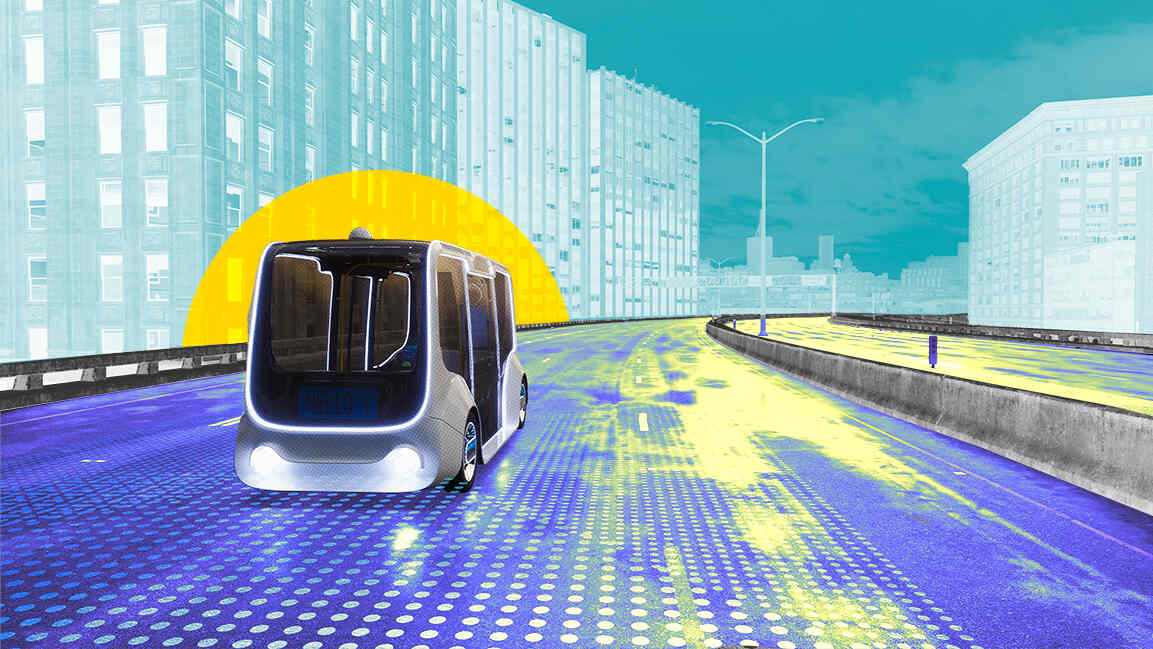- | 9:00 am
How Qatar is finding its lane on the road to autonomous mobility
The country is driving homegrown innovation and accelerating its transition to a smart mobility hub

Driverless cars are speeding onto our streets, and flying taxis will take off sooner than you’d think. In the Middle East, governments and businesses are the most bullish self-driving proponents, aiming to transform urban mobility as we know it.
Last December, Uber and WeRide launched the Middle East’s first commercial driverless mobility service in Abu Dhabi. And next year, you’ll soon be able to take a 10-minute low-cost flight between some of Dubai’s busiest landmarks. Thanks to a collaboration between the Dubai Roads and Transport Authority, JOBY Aviation, and Skyports Infrastructure.
In Dubai, the General Civil Aviation Authority has begun mapping dedicated air corridors connecting key international airports and major landmarks and establishing a regulatory framework for flying taxis and cargo drones. These aerial routes and regulations are expected to be finalized within the next two years.
Saudi Arabia, which wants 15% of its public transport vehicles to be autonomous by 2030, has launched a project for driverless cars, which could result in government agencies using them as early as this year.
The transport ministry launched a trial driverless minibus called the Dhahaina, which is installing smart communication devices along roadways that interact with autonomous vehicles.
No wonder, propelled by substantial government investments and strategic initiatives, the region’s autonomous vehicle (AV) market was valued at about $2 billion in 2023 and is projected to grow at a compound annual growth rate of around 12.3% from 2024 to 2032.
As the region accelerates its adoption of AV technology, Qatar is emerging as a significant player in the AV sector, driven by rising government support and demand for sustainable mobility solutions.
In the last few years, the country has quietly been testing the technology. In 2021, Conical Systems and Talabat partnered with Education City in Qatar to trial autonomous door-to-door delivery services. In 2022, Yutong, a Chinese manufacturer of Level 4 autonomous buses, carried out road tests at Qatar Foundation.
NOTABLE STEPS BEING TAKEN
Its five-year plan, unveiled in 2023, took the lead in regulating self-driving vehicles under its smart and environmentally conscious transport system.
“We are seeing notable steps being taken in Qatar with a five-year plan that goes beyond regulating AV technology to actively shaping the future of smart mobility,” says Dr. Jack Lau, President of Qatar Science & Technology Park (QSTP). “This initiative focuses on integrating AI-driven transport solutions, enhancing urban connectivity, and positioning the country as a leader in autonomous mobility,” he adds.
Recently, the country trialed Level 4 AV solutions at Hamad International Airport in collaboration with QSTP. It is testing AI-powered autonomous buses and baggage tractors equipped with intelligent sensors and Lidar technology to enhance operational efficiency and sustainability.
By supporting projects, Dr. Lau says, QSTP, which works with some of the largest AV companies in various industries, including UISEE and Blue Future, is driving homegrown innovation and accelerating Qatar’s transition to a smart mobility hub.
With over 350 miles of coastline, rich marine life, and abundant offshore energy resources, Blue Future is helming the evolution of Unmanned Surface Vessels (USVs), aiming to integrate USV and AI technology into Qatar’s marine landscape—from traditional shipbuilding and offshore energy to marine surveying, maritime transport, and even tourism.
“USV is a promising starting point for the region looking to propel the AV industry,” says Pinestone Shi, General Manager of Blue Future.
In Qatar, Chinese AV company UISEE aims to leverage its AI expertise and advanced technologies to support the country’s sustainable development goals, particularly in transportation and logistics. “By utilizing the robust ecosystem of QSTP, UISEE hopes to contribute comprehensively to the country’s innovation ambitions,” says Andrew Guo, Qatar’s general manager of UISEE.
“The scope of AV applications is broad and transformative, spanning passenger vehicles, robotaxis, autonomous buses, long-haul logistics, urban freight, last-mile delivery, sanitation, and patrolling,” Guo adds.
IMPACTING DAILY LIFE
Qatar has an ambitious vision for the years ahead as various organizations develop AVs. In the coming years, AVs can significantly impact daily life, including reducing carbon footprint, improving traffic management, and providing mobility solutions for individuals unable to drive, such as the elderly and disabled.
Beyond passenger transport, autonomous trucks and delivery vehicles can streamline supply chains, reduce operational costs, and improve accuracy and efficiency. “The integration of AVs into public transportation systems also holds the potential to make urban mobility more efficient and accessible,” says Dr. Lau.
According to Shi, AVs, particularly USVs, will revolutionize lives “by extending their influence beyond transportation to activities like seabed mapping, offshore engineering, and marine conservation.”
He adds, “Less than 10% of the ocean is explored due to harsh conditions and limited tools. USVs will enable remote ocean exploration, vastly improving our ability to use and protect marine resources.”
PRIORITIZE PEOPLE OVER VEHICLES
AVs offer a unique opportunity to redesign urban environments to prioritize people over vehicles. Because AVs can travel closer together and more efficiently, cities can reduce road widths and repurpose excess space for pedestrian pathways, green areas, and bike lanes.
With AVs, cars could autonomously park at centralized locations on city outskirts or circulate within cities without stopping, freeing up space for green areas, plazas, or commercial activities, says Guo. “AVs also enable more efficient traffic management, allowing for narrower lanes and fewer roads, enhancing pedestrian-friendly environments.”
This shift can lead to more walkable and livable urban spaces, decreased traffic congestion, and improved air quality. Additionally, the reduced need for extensive parking facilities allows for developing community-centric spaces, further enhancing the quality of urban life.
WILL THE PUBLIC LEARN TO TRUST THEM?
But there’s a catch: The increase in incidents involving self-driving vehicles globally has raised concerns about public safety. Will the public learn to trust them?
Since the technology is evolving, unforeseen challenges can arise, and so Dr. Lau says developers, regulators, and policymakers must collaborate closely to establish comprehensive safety standards and regulations.
“Continuous monitoring, transparent reporting of incidents, and adaptive regulatory frameworks are essential to ensure that AV deployment prioritizes public safety and maintains public trust.”
Establishing public trust in AV technology is challenging but essential for widespread adoption. Robust regulations and standards are crucial to ensure safety and build consumer confidence.
Transparent communication about AVs’ capabilities and limitations, along with consistent safety records, can help gain public trust. Engaging with communities, addressing their concerns, and demonstrating the tangible benefits of AVs, such as improved safety and accessibility, are vital steps in this process.
According to Guo, AV systems perform well in 99.99% of scenarios but face challenges in addressing “long-tail” issues. “Achieving AV systems that surpass human drivers in all situations could take 5–10 years,” he says, adding that the industry must demonstrate consistent safety and accident reduction improvements to gain public trust.
UNIQUE CHALLENGES
Implementing AVs presents unique challenges in the region. Extreme temperatures can affect sensor performance and battery life, necessitating technological adaptations and diverse driving behaviors that require highly adaptable AV systems.
Additionally, the existing infrastructure requires significant investments in smart road systems and communication networks.
Also, in the region, there’s a lack of detailed AV laws covering safety certifications, road permissions, and liability, creating uncertainties for companies and consumers. As a geopolitical hotspot, the Middle East, including Qatar, is a prime target for cyberattacks.
“AV systems introduce new vulnerabilities, making robust cybersecurity essential,” says Guo.
Addressing these challenges will require collaboration between government, technology providers, and urban planners to develop tailored solutions that ensure AVs’ safe and effective integration into the transportation systems.






































